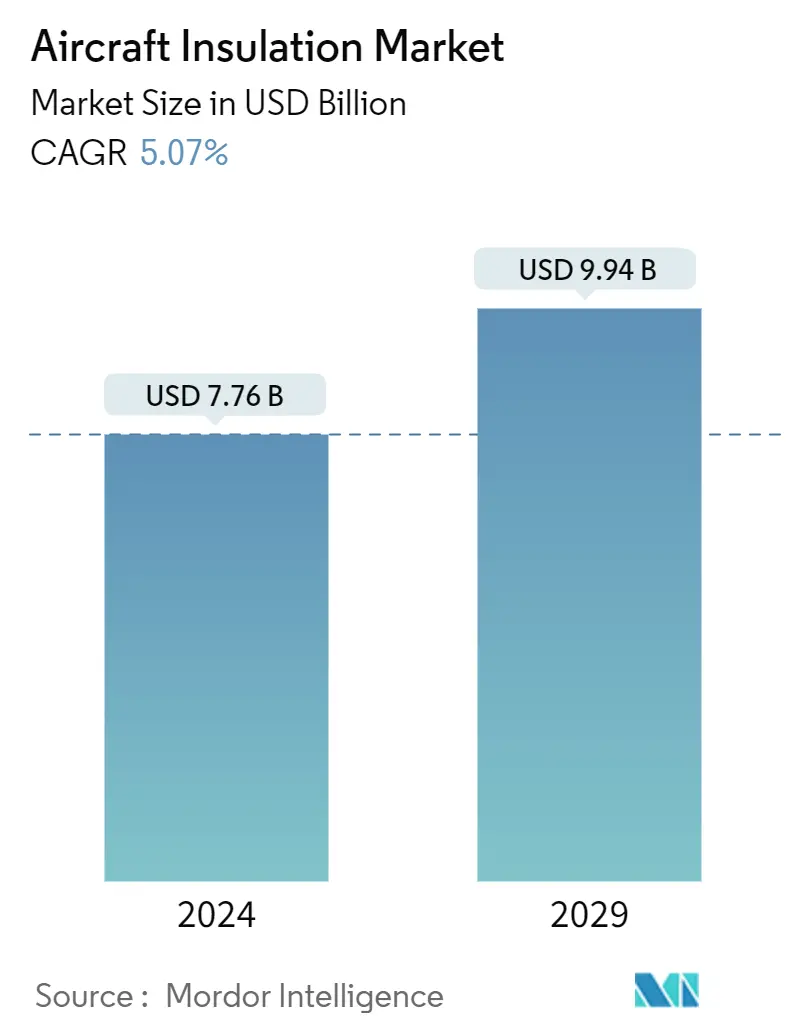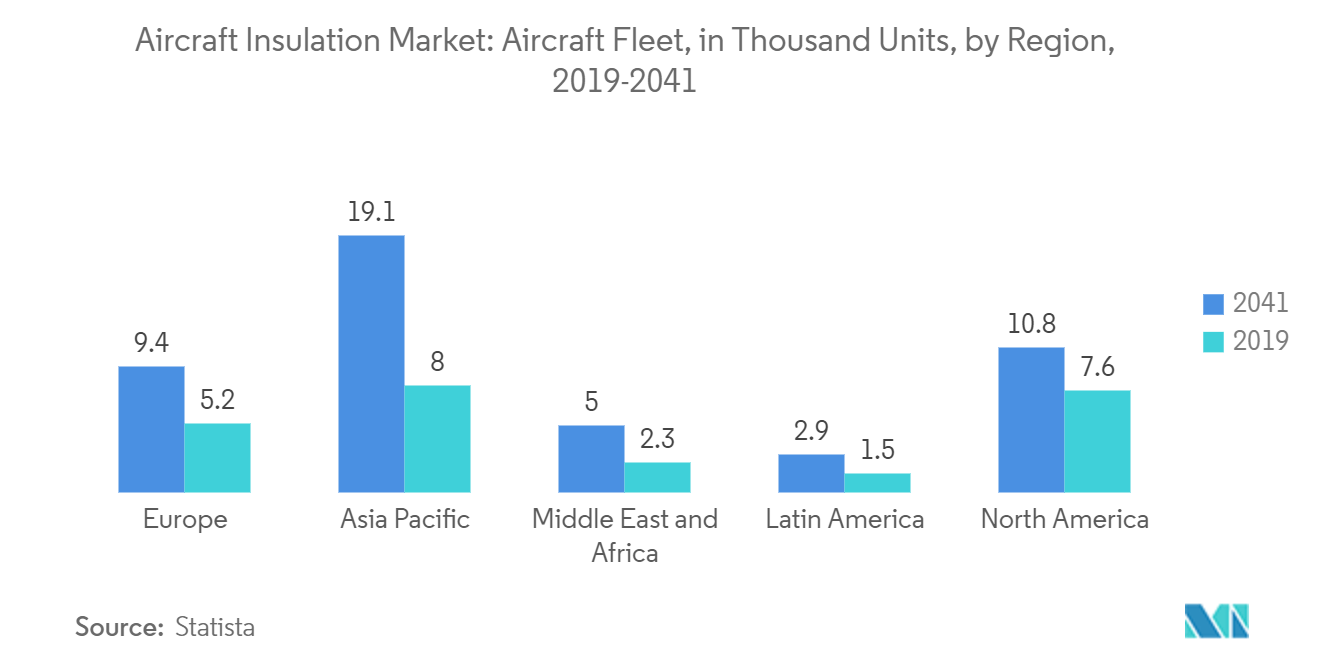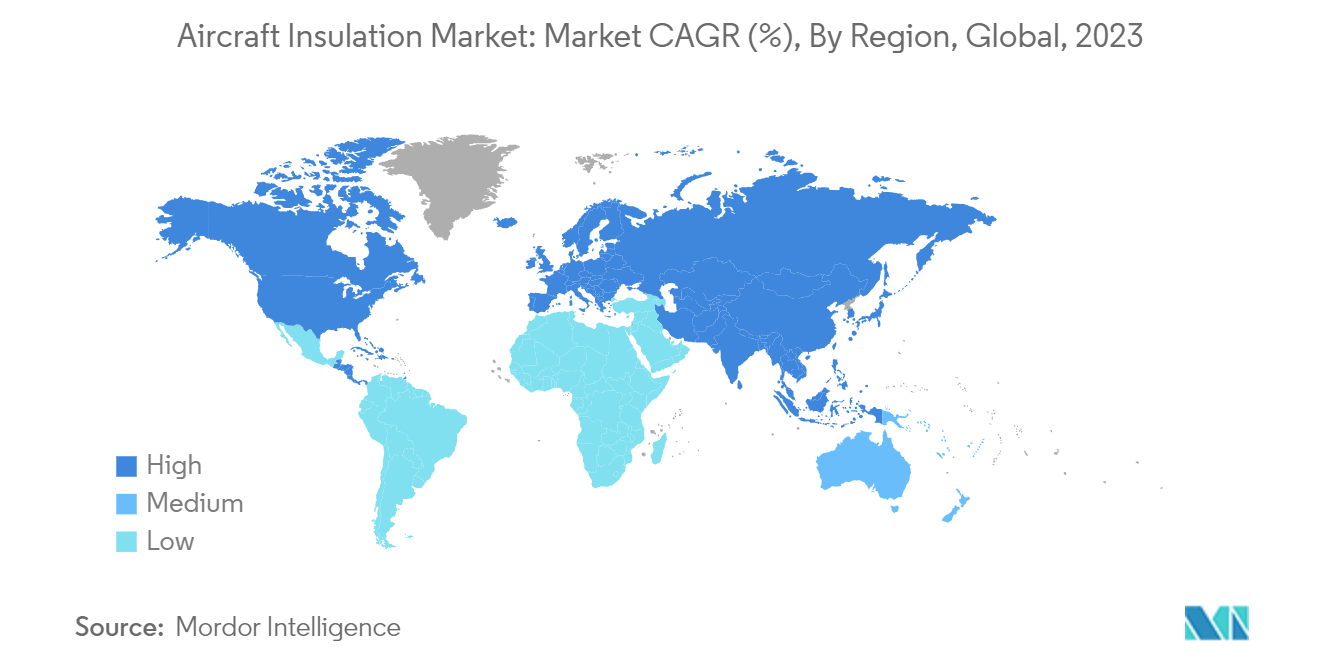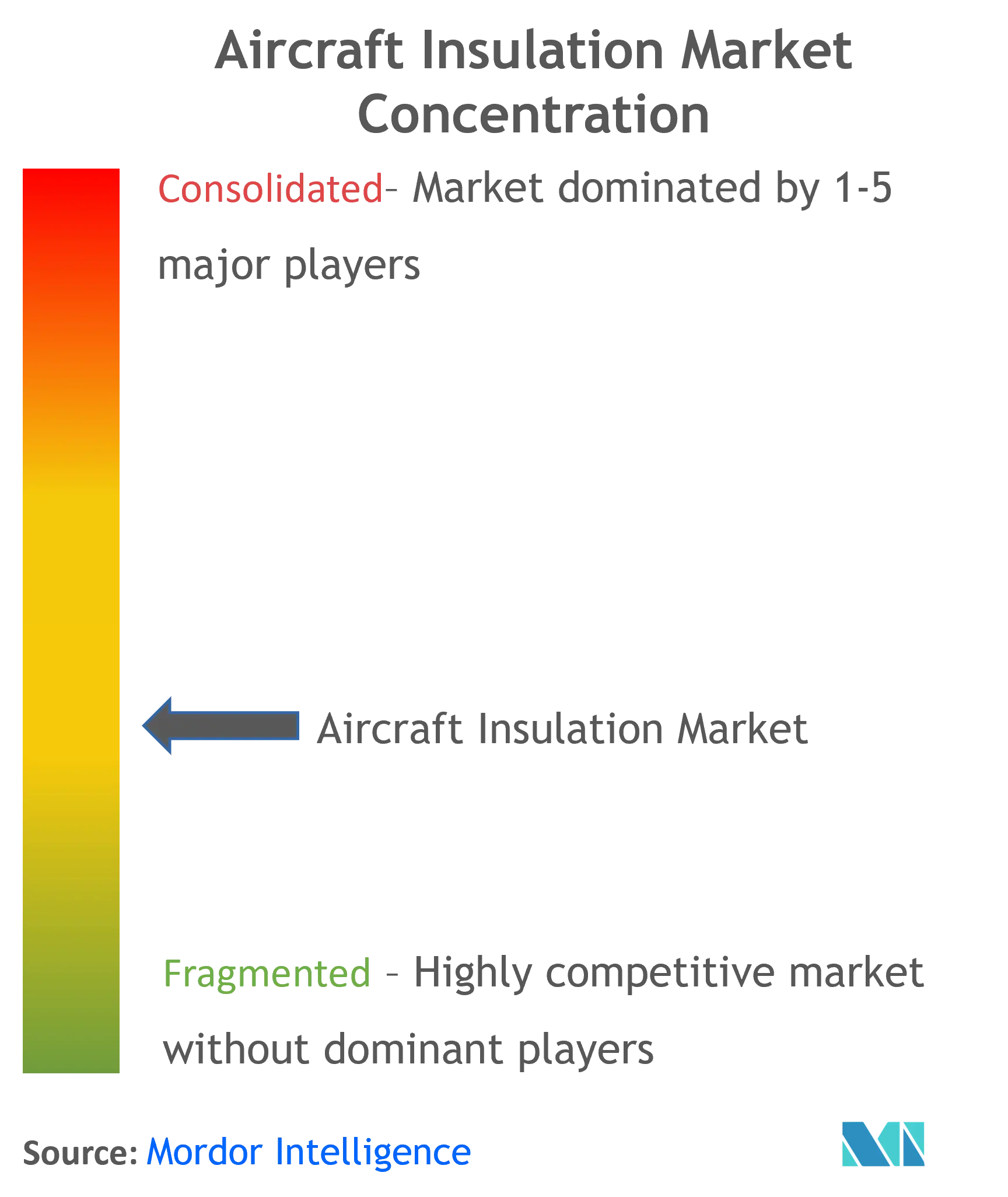Aircraft Insulation Market Size

| Study Period | 2019 - 2029 |
| Market Size (2024) | USD 7.76 Billion |
| Market Size (2029) | USD 9.94 Billion |
| CAGR (2024 - 2029) | 5.07 % |
| Fastest Growing Market | Asia Pacific |
| Largest Market | North America |
Major Players
*Disclaimer: Major Players sorted in no particular order |
Aircraft Insulation Market Analysis
The Aircraft Insulation Market size is estimated at USD 7.76 billion in 2024, and is expected to reach USD 9.94 billion by 2029, growing at a CAGR of 5.07% during the forecast period (2024-2029).
To provide more safety and comfort to the passengers, the aircraft OEMs, and airlines are using different aircraft insulation materials on the aircraft, which is driving the market growth. The use of insulation materials is rapidly increasing due to advantages such as reduced vibration and noise during flying hours. The growing use of composite materials in commercial aircraft is forecast to result in the development of a wide range of aerostructures, which are likely to have significant industrial potential. The market is likely to be stimulated by increasing demand for lightweight insulating and composite materials in commercial airplanes and business aircraft, to reduce cabin noise.
Growth in aircraft sales and production, especially from the commercial segment, is generating demand for insulation systems for aircraft, thereby propelling growth in the market revenue. Moreover, stringent regulations from regulatory bodies, like the FAA, in terms of survivability and capability of the materials in various environments, are challenging the growth of the players in the market. Under the US FAA's definition, all commercial aircraft must be fitted with thermal and acoustic insulation. These insulations ensure the comfort of passengers does not depend on external temperature variations and that communications are unaffected by noise generated by an aircraft. Such strict rules are making it easier for airplane manufacturers to use insulation materials in airplanes, increasing the market for aircraft insulation.
Aircraft Insulation Market Trends
The Commercial Aircraft Segment Registered the Highest Market Share
The market for the commercial aircraft segment is currently larger, which is mainly due to the high sales of the aircraft models. The air transport sector is expanding fast and is expected to continue like this over the next few years. The International Air Transport Association estimates that, until 2036, demand for air transport will increase at an annual rate of 4.3%. If that growth is achieved by 2036, the air transport sector will likely contribute 15.2 million directly employed jobs and USD 1.5 trillion of GDP to the global economy over the forecast period. On average, the usage of insulation in commercial aircraft is generally higher as compared to the other aircraft types.
With the growing emphasis on increasing the passenger experience, better thermal/vibration/acoustic insulating materials are being used on the newer generation aircraft compared to the older aircraft types. The mandates imposed by EASA and FAA regarding fire-resistant thermal-acoustic insulation have propelled the growth of the insulation market for commercial aircraft. Though the newer aircraft models are the first to implement the updated mandates, older commercial aircraft have also seen some retrofitting activity in the last two years due to these regulations.
With an increase in air transport demand, airlines are ordering and procuring new aircraft on a large scale. Simultaneously, with a huge order backlog with the aircraft OEMs, production rates are increasing, which will increase the demand for aircraft insulation materials. On this note, in September 2022, Ethiopian Sky Technologies inaugurated a manufacturing facility in Addis Ababa to produce insulation blankets for Boeing B737 MAX aircraft as part of a Boeing agreement (BSCA) between The Boeing Company, Geven-Skytecno and Ethiopian Airlines. Hence, the market for aircraft insulation in the commercial segment is expected to dominate the market in the future.

Asia-Pacific to be the Fastest-growing Market in the Forecast Period
As passenger traffic in the region is continuously growing, airlines are adopting various growth strategies. By 2025, China is forecasted to become the world's largest aviation market in terms of air traffic; India is forecasted to develop into the world's third-largest aviation market, while other countries, such as Indonesia and Thailand, are forecasted to enter the top 10 global markets.
Some of the airlines are procuring new aircraft and are expanding their routes to places where there is a growth impetus. For instance, in June 2023, Indigo (India) ordered 500 Airbus A320neo family planes at the Paris Air Show. Similarly, Air India (India) has signed purchase agreements for 250 Airbus aircraft and 220 new Boeing jets worth USD 70 billion. Air India's orders include 70 widebody planes, comprising 34 A350-1000s and six A350-900s from Airbus, 20 B787 Dreamliners, and 10 B777Xs from Boeing. It also includes 140 Airbus A320neo, 70 Airbus A321neo, and 190 Boeing B737 MAX narrowbody aircraft. The airline has also signed options to buy an additional 70 aircraft from Boeing, including 50 B737 MAXs and 20 B787 Dreamliners. For instance, Airbus A320, A330, and A350 aircraft are provided with acoustic insulation by Allied International, Triumph Aerospace Structures, and Daher. Triumph Aerospace Structures is the manufacturer of the thermal acoustic insulation systems installed onboard the Airbus A330, A350, Boeing B737, B767, B777, and Dreamliner B787 aircraft families.
While DuPont Aerospace, Hi-Temp Insulation, Inc. provides fire insulation, 3M Canada provides thermal insulation for the Boeing B787 Dreamliner and the COMAC ARJ21 aircraft. Such procurement orders would drive the business prospects of the market players during the forecast period. The insulation needed for the air conditioning/heating system to economically produce cabin temperatures that appeal to the passengers varies with the airplane type and location where the aircraft operates. With most of the region lying in the hot, tropical zone, even the operators of general aviation aircraft in the region use different materials for thermal insulation to make travel comfortable for the passengers. Hence, the market is expected to grow faster in the Asia Pacific compared to the other regions.

Aircraft Insulation Industry Overview
The aircraft insulation market is semi-consolidated. DuPont de Nemours, Inc., BASF SE, Triumph Group Inc., Boyd Corporation, and Polymer Technologies Inc. are some of the major players in the aircraft insulation market. Innovations, in terms of new insulation materials, will help the players gain new contracts. Moreover, due to the increasing emphasis on lightweight components in the aviation industry, the players are focusing on developing advanced insulation materials, mainly thermal/acoustic insulations.
With the stringency of the regulations in terms of insulation safety increasing, it is becoming difficult for smaller players to penetrate the market. The Federal Aviation Administration (FAA) is developing new flammability test requirements for aircraft insulation that will result in increased fire safety on aircraft. On this note, the product offerings of the insulation suppliers must be upgraded to suit the regulatory requirements of the governing bodies.
Frequent upgrades to the product offerings based on the trends and requirements will help the players sustain the market competition in the long run. For instance, in August 2023, Ethiopian Airlines Group erected an aircraft component manufacturing plant at Kilinto Industrial Park in a joint venture with Boeing. The plant will likely manufacture various aerospace internal parts, including aircraft thermo-acoustic insulation blankets, electrical wire harnesses, and more. These internal components will be supplied to Boeing, Airbus, and an Italian aircraft manufacturing company, according to the IPDC.
Aircraft Insulation Market Leaders
-
BASF SE
-
DuPont de Nemours, Inc.
-
Triumph Group, Inc.
-
Boyd Corporation
-
Polymer Technologies, Inc.
*Disclaimer: Major Players sorted in no particular order

Aircraft Insulation Market News
January 2023: Aerogel Core Ltd. developed next-generation materials for the aerospace and automotive industries; the company launched ultra-light, low-carbon 'aerogel' insulation materials for the aviation and auto industries, which can be used as soundproofing and heat-shielding materials.
February 2022: Triumph Group, Inc. was awarded a contract with Airbus to design, manufacture, and provide full program lifecycle support on the primary thermal acoustic insulation system for the Airbus Canada A220 aircraft.
Aircraft Insulation Market Report - Table of Contents
1. INTRODUCTION
- 1.1 Study Assumptions
- 1.2 Scope of the Study
2. RESEARCH METHODOLOGY
3. EXECUTIVE SUMMARY
4. MARKET DYNAMICS
- 4.1 Market Overview
- 4.2 Market Drivers
- 4.3 Market Restraints
-
4.4 Industry Attractiveness - Porter's Five Forces Analysis
- 4.4.1 Bargaining Power of Suppliers
- 4.4.2 Bargaining Power of Buyers/Consumers
- 4.4.3 Threat of New Entrants
- 4.4.4 Threat of Substitute Products
- 4.4.5 Intensity of Competitive Rivalry
5. MARKET SEGMENTATION
-
5.1 Insulation Type
- 5.1.1 Electric Insulation
- 5.1.2 Thermal Insulation
- 5.1.3 Acoustic and Vibration Insulation
-
5.2 Application
- 5.2.1 Commercial Aircraft
- 5.2.2 Military Aircraft
- 5.2.3 General Aviation Aircraft
-
5.3 Geography
- 5.3.1 North America
- 5.3.1.1 United States
- 5.3.1.2 Canada
- 5.3.2 Europe
- 5.3.2.1 United Kingdom
- 5.3.2.2 Germany
- 5.3.2.3 France
- 5.3.2.4 Italy
- 5.3.2.5 Rest of Europe
- 5.3.3 Asia-Pacific
- 5.3.3.1 China
- 5.3.3.2 Japan
- 5.3.3.3 India
- 5.3.3.4 South Korea
- 5.3.3.5 Rest of Asia-Pacific
- 5.3.4 Latin America
- 5.3.4.1 Brazil
- 5.3.4.2 Mexico
- 5.3.4.3 Rest of Latin America
- 5.3.5 Middle East and Africa
- 5.3.5.1 United Arab Emirates
- 5.3.5.2 Saudi Arabia
- 5.3.5.3 Turkey
- 5.3.5.4 South Africa
- 5.3.5.5 Rest of Middle East and Africa
6. COMPETITIVE LANDSCAPE
- 6.1 Vendor Market Share
-
6.2 Company Profiles
- 6.2.1 DuPont de Nemours, Inc.
- 6.2.2 BASF SE
- 6.2.3 HUTCHINSON SA
- 6.2.4 Triumph Group, Inc.
- 6.2.5 Boyd Corporation
- 6.2.6 Duracote Corporation
- 6.2.7 Hi-Temp Insulation, Inc.
- 6.2.8 Polymer Technologies, Inc.
- 6.2.9 Evonik Industries AG
- 6.2.10 Zotefoams plc
- 6.2.11 DUNMORE Europe GmbH
- *List Not Exhaustive
7. MARKET OPPORTUNITIES AND FUTURE TRENDS
** Subject To AvailablityAircraft Insulation Industry Segmentation
The materials fitted in aircraft to increase safety and comfort levels are referred to as aerospace insulation. In severe weather conditions, the aircraft's functions shall be guided by some basic operations and safety measures in the field of weight and temperature terms and overall performance. Aircraft insulation plays an important role in protecting crew and passengers at higher elevations from generator noise and colder temperatures.
The aircraft insulation market is segmented by insulation type, application, and geography. The aircraft insulation market is segmented by insulation type into electric insulation, thermal insulation, and acoustic and vibration insulation. By application, the market is segmented into commercial aircraft, military aircraft, and general aviation aircraft. The report also covers the market sizes and forecasts for the aircraft insulation market in major countries across different regions. For each segment, the market size is provided in terms of value (USD).
| Insulation Type | Electric Insulation | |
| Thermal Insulation | ||
| Acoustic and Vibration Insulation | ||
| Application | Commercial Aircraft | |
| Military Aircraft | ||
| General Aviation Aircraft | ||
| Geography | North America | United States |
| Canada | ||
| Geography | Europe | United Kingdom |
| Germany | ||
| France | ||
| Italy | ||
| Rest of Europe | ||
| Geography | Asia-Pacific | China |
| Japan | ||
| India | ||
| South Korea | ||
| Rest of Asia-Pacific | ||
| Geography | Latin America | Brazil |
| Mexico | ||
| Rest of Latin America | ||
| Geography | Middle East and Africa | United Arab Emirates |
| Saudi Arabia | ||
| Turkey | ||
| South Africa | ||
| Rest of Middle East and Africa |
Aircraft Insulation Market Research FAQs
How big is the Aircraft Insulation Market?
The Aircraft Insulation Market size is expected to reach USD 7.76 billion in 2024 and grow at a CAGR of 5.07% to reach USD 9.94 billion by 2029.
What is the current Aircraft Insulation Market size?
In 2024, the Aircraft Insulation Market size is expected to reach USD 7.76 billion.
Who are the key players in Aircraft Insulation Market?
BASF SE, DuPont de Nemours, Inc., Triumph Group, Inc., Boyd Corporation and Polymer Technologies, Inc. are the major companies operating in the Aircraft Insulation Market.
Which is the fastest growing region in Aircraft Insulation Market?
Asia Pacific is estimated to grow at the highest CAGR over the forecast period (2024-2029).
Which region has the biggest share in Aircraft Insulation Market?
In 2024, the North America accounts for the largest market share in Aircraft Insulation Market.
What years does this Aircraft Insulation Market cover, and what was the market size in 2023?
In 2023, the Aircraft Insulation Market size was estimated at USD 7.37 billion. The report covers the Aircraft Insulation Market historical market size for years: 2019, 2020, 2021, 2022 and 2023. The report also forecasts the Aircraft Insulation Market size for years: 2024, 2025, 2026, 2027, 2028 and 2029.
Aircraft Insulation Industry Report
Statistics for the 2024 Aircraft Insulation market share, size and revenue growth rate, created by Mordor Intelligence™ Industry Reports. Aircraft Insulation analysis includes a market forecast outlook to for 2024 to 2029 and historical overview. Get a sample of this industry analysis as a free report PDF download.



